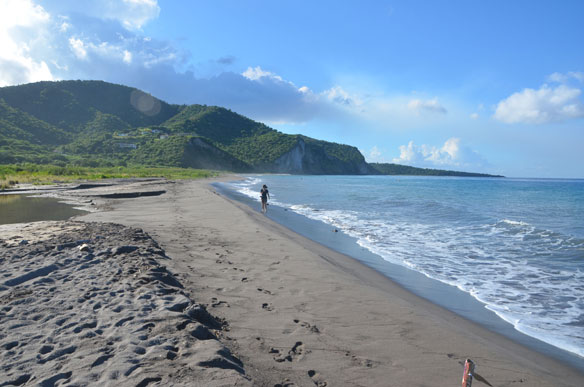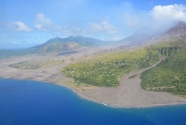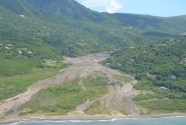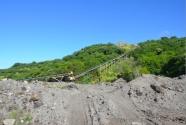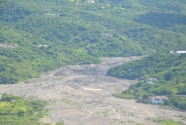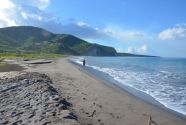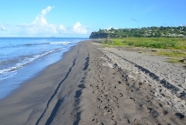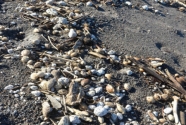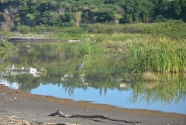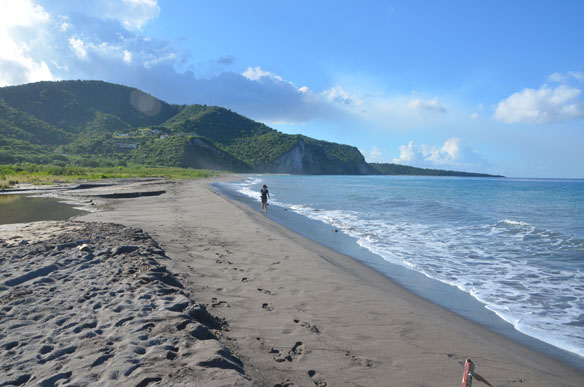
By Katie Peek and Rob Young, Program for the Study of Developed Shorelines / Western Carolina University
Isles Bay Beach is a small, embayed beach located on the western side of the Caribbean Island of Montserrat. This mountainous island is a British oversees territory, less than 20 square miles in area and dominated primarily by the Soufriere Hill Volcano. In 1995, the volcano began to erupt for the first time in recorded history, spewing ash and deadly pyroclastic flows directly on the capital of Plymouth, south of Isles Bay. Because the volcano continues to be active, the southern part of the island surrounding the volcano has been deemed an “exclusion zone” (See Map). These eruptions have forced over half of the population to relocate to other countries, primarily the United Kingdom.
Isles Bay Beach is located at the mouth of the Belham River, which runs west down from Soufriere Hills Volcano. Although the river is often no more than a trickle, the valley has been the recipient of significant volcanic debris flows since the eruptions began. In fact, the valley has more than doubled in width since 1995, with sediment flows covering many properties, including the island’s golf course.
As a result of the continued eruptions, the island has a large resource of volcanic sand located inland of the coast. The mining and exportation of this sand has steadily increased over the past 15 years. Originally, the sand mining was predominantly along the eastern, less populated side of the island, near the town of Trants. An eruption in 2010 covered this region with fresh pyroclastic material, destroying equipment and roads, and forcing the sand mining companies to look for another location. Recently, the sand mining has moved to the Belham Valley on the western side of the island.
… the current plan to export sand through the construction of new infrastructure along one of the most pristine, undeveloped beaches in the Caribbean, is not the answer…
—Katie Peek and Rob Young
The sand mined in Belham Valley is transported over 10 miles north to Little Bay, the location of the only viable pier (jetty) outside of the exclusion zone. The transport of this material by truck through Montserrat has caused much concern within the community, due to the noise, pollution, and the wear and tear on small residential roads. Therefore, the government is entertaining the option of building a new pier (jetty) for shipping the mined sand much closer to the source on the south end of Isles Bay Beach, just down Belham Valley.
This proposal has been criticized by property owners on the flanks of the Belham Valley, in the communities of Old Towne and Isles Bay Hill. Although a pier on Isles Bay Beach would eliminate the need to truck the sand across Montserrat, there is concern about the impacts the pier could have on the beach and coastal zone of Isles Bay.
The beach is currently used by fisherman, used as a recreational resource for the people of Montserrat, as well as a nesting beach for hawksbill turtles. Construction of this pier and an access road along the beach could potentially cause harm to the natural environment.
A recent Environmental Impact Assessment (EIA) of the mining activities was completed at the request of the Government of Montserrat. The EIA raises significant concerns about the impact that vehicular traffic will have on turtle nesting along the beach. This alone would kill the project in most places. Unfortunately, the EIA does not address the potential impacts that the new pier (jetty) will have on coastal process or nearshore habitat. The beach protects significant wetland ecosystems just landward of the sandy berm.
We have always advocated for the use of inland sources of sand in the Caribbean, and the Island of Montserrat has good sand. We hope that all parties can work together to find an organized approach to exploiting the resource that is sustainable, environmentally friendly, and economically rewarding.
We fear that the current plan to export the sand through the construction of new infrastructure along one of the most pristine, undeveloped beaches in the Caribbean is not the answer.

